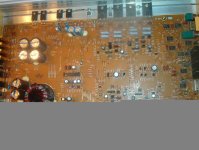While trying to hook up this amp, I accidently blew it, not sure how, but it happened while tightening the screws that hold the ground, power, etc. There was a spark and a puff of smoke from where the spark emitted, and now the amp wont turn on. The spark hit on the chassis of the whole thing near a screw. So now Im trying to repair it and could use some guidelines as to where to look for a problem and how. Any help would be much appreciated. Thank you!
Assuming that you've checked the fuses and used a multimeter to verify that you have voltage at the amplifier (+B and remote) and a good ground...
If you shorted the power input to the chassis of the amp, you may have opened a trace on the board. With the system set where the amp should be on, measure the voltage from a known good ground to the case of the amplifier. If you read ~12 volts, it's likely that you have an open trace. To repair it, you'd have to disassemble the amplifier and jump the open trace.
This is why it's important to remove fuses when making power connections.
If you shorted the power input to the chassis of the amp, you may have opened a trace on the board. With the system set where the amp should be on, measure the voltage from a known good ground to the case of the amplifier. If you read ~12 volts, it's likely that you have an open trace. To repair it, you'd have to disassemble the amplifier and jump the open trace.
This is why it's important to remove fuses when making power connections.
Many amplifiers have the chassis of the amplifier directly connected to the ground connection of the amplifier. Depending on the point where the heatsink is grounded on the circuit board and the layout of the power/ground terminals, the ground connection can be opened when the power terminal is shorted to the heatsink (via a screwdriver in most cases). When the ground opens, the heatsink's connection to ground is broken (along with the grounds for other electronic components). Since a small current can flow from the positive terminal through various electronic components to the heatsink, the heatsink may have something near battery voltage on it. If you can get the amp to turn on by grounding the heatsink AND the ground terminal, then you have an open trace. This is NOT a permanent fix. Grounding through the heatsink may open other traces when high current is drawn by the amp. Depending on what traces open, serious damage may occur.
I should mention that not all amplifiers have their heatsinks grounded directly. Some use small capacitors to drain any 'noise' from the heatsink to ground. The 'noise' is commonly from capacitive coupling between the power supply components and the heatsink. If your amplifier has a capacitor between the heatsink ground and the chassis ground, then you may be able to measure a tiny bit of voltage on the heatsink but the voltage would likely be quickly drained away by your volt meter.
The following link shows a Pioneer amp that was damaged by shorting the heatsink to B+.
http://www.bcae1.com/pioneerampfordiyforum01.swf
I should mention that not all amplifiers have their heatsinks grounded directly. Some use small capacitors to drain any 'noise' from the heatsink to ground. The 'noise' is commonly from capacitive coupling between the power supply components and the heatsink. If your amplifier has a capacitor between the heatsink ground and the chassis ground, then you may be able to measure a tiny bit of voltage on the heatsink but the voltage would likely be quickly drained away by your volt meter.
The following link shows a Pioneer amp that was damaged by shorting the heatsink to B+.
http://www.bcae1.com/pioneerampfordiyforum01.swf
- Status
- This old topic is closed. If you want to reopen this topic, contact a moderator using the "Report Post" button.
- Home
- General Interest
- Car Audio
- Dead Pioneer Amp

